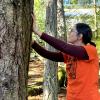
May 15, 2014 - 7:00am
A rare opportunity to learn about First Nations healing and cultural practices brought together 370 students, faculty and members of the region’s health professions for two days last month at the Snuneymuxw Nation’s Big House.
Organized by Vancouver Island University’s (VIU) Office of Aboriginal Education and Health and Human Services (HHS), the second annual “Seasons of Health and Healing” forum April 10 and 11 involved presentations by First Nations Elders and demonstrations by 15 different Aboriginal healing practitioners.
Holly Gale, a second year Bachelor of Science in Nursing student at VIU, said the opportunity to spend two days learning in the Snuneymuxw people’s sacred gathering place was a wonderful experience, and very important for health care professionals in training and working in Aboriginal communities.
“We work with so many First Nation communities, and being able to understand a bit more about their culture, and what their cultural needs are, is really important,” she said.
Gale said her feelings were mixed when given the opportunity to experience two different First Nations healing sessions firsthand.
“I was just a little uncomfortable – I had this feeling ‘here I am, a white settler receiving First Nations medicine, while there’s another white settler across the hall receiving First Nations medicine that’s not their own.’ But at the same time, I recognize why events like this are super important, because people will never protect what they don’t understand or what they haven’t experienced.”
Many of the students have shared that they had very deep, personal responses to what they observed and learned in the Snuneymuxw Big House over the two-day session, said Geraldine Manson, VIU Elder in Residence and co-chair of the event.
“I’ve had many students come to visit me afterwards, and I’ve heard them say what a wonderful feeling it was to connect with the learning and participate in our longhouse,” Manson said.
Nicasio Campos, who recently completed the first year of a Bachelor of Arts degree as he works towards a degree in Social Work at VIU, said he had a very positive personal experience listening to the Elders’ teachings, and learning about First Nations spirituality and perspectives on healing. After a rough first semester, he said his experience at the Seasons of Health and Healing “brought something out in me that was missing, and changed things around for me.”
Campos said he thinks it’s important to recognize spiritual health as well as cultural differences when working in the health care professions.
“Spiritual health is something that is missing in western society and culture,” he said. “In other cultures around the world, they take spirituality as seriously as eating – I think it’s something we lack.”
One theme echoed by Elders in their presentations was the need for healers to take care of themselves first, in order to care for others.
One Elder’s story resonated deeply for Gale, who said she knows she is not alone is asking ‘what difference can I make’ in the work she chooses to do.
“On the second day, one of the Elders told a story about a forest fire, where all the big animals started coming down out of the forest. As one of the last big bears trundled down off the mountain, away from the fire, a hummingbird went the other way toward the fire. The little bird went up to the fire and spat the water in its mouth onto the fire, then whipped back down to the creek and headed back up to the fire with another little mouthful, and did it again,” Gale recounted.
“The big bear asked ‘Hummingbird, what are you doing?’ And the hummingbird said, “What I can.”
“That story pulled my heart right out of my chest,” Gale said. “So often in the health care field we ask ourselves, ‘what difference is this going to make’’ And then to hear this story… we can only do what we can do.”
Dr. Carol Stuart, Dean of Health and Human Services and co-organizer of the event with Manson, said she believes the Seasons of Health and Healing event is vital to the experience of students in HHS programs at VIU.
“It’s about helping students and faculty feel comfortable with the unknown of First Nations spirituality and perspectives on healing,” she said. “The privilege of going into the long house and to experience what’s inside as well as to hear the teachings of the presenters and the opportunity to experience healing sessions, gives them a completely different understanding of the Coast Salish people.”
Campos for one will long remember the experience of the Big House, and the revelation that he is on the right path.
Gaining new insights into First Nations health, healing and spirituality cannot be underestimated as a generous gift from the First Nations people who opened their longhouse to students, he said.
“It means so much because after the years of colonization, and all that they have been through, they are still giving. That’s the best example for me. And I have a huge amount of respect for them.”
Stuart said First Nations perspectives on health and healing are an important part of HHS program curriculum, with two programs currently including formalized learning with First Nations Elders in the classroom.
“We have other faculty who want to bring these teachings into their classrooms, informally at first,” she said. “Seasons of Health and Healing tells us that we need to do this consciously, as the next piece of the work, on campus and in our classrooms.”
-30-
Media Contact:
Shari Bishop Bowes, Communications Officer, Vancouver Island University
P:250.740.6443 C: 250.618.1535 E: Communications@viu.ca T: @viunews
Tags: Teaching and Learning






